Melbourne Tram Museum
- Follow Melbourne Tram Museum on Twitter
- Follow Melbourne Tram Museum on Facebook
- Follow Melbourne Tram Museum on Instagram
- Follow Melbourne Tram Museum on Pinterest
- Follow Melbourne Tram Museum on Tumblr
- Subscribe to Melbourne Tram Museum's RSS feed
- Email Melbourne Tram Museum
What tram do I catch? An incomplete history of Melbourne tram route numbers
Visitors to our museum often ask about the rationale behind Melbourne’s tram route numbers, and how they came to be allocated. To the average commuter, there seems to be neither rhyme nor reason to the numbers. To understand why they are what they are, we need to delve right back to the beginning of Melbourne’s tramway system in 1885.
A quick and easy way for commuters to identify where a tram is going has always been required. Now it is achieved using route numbers in combination with destination signs, but this wasn’t always the case.
Back in the 1880s the management of the Melbourne Tramway and Omnibus Company (MTOC) took a common-sense approach, suitable for the low literacy levels of the Victorian era. Not only did MTOC paint the sides and ends of its tramcars with the route names, it also colour-coded the tramcars according to route as well as displaying a matching coloured light for night-time travellers.
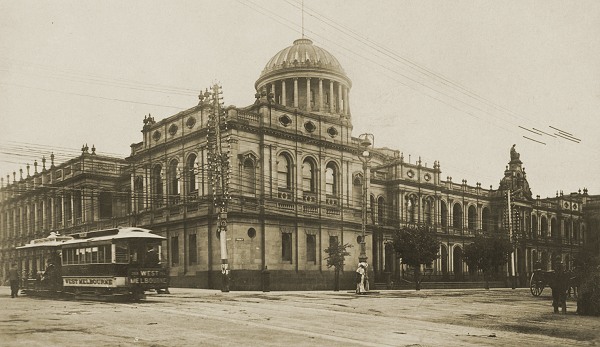
Supreme Court building at the corner of Lonsdale and William Streets, with MTOC cable tram No 258 inbound from West Melbourne to the Elizabeth Street terminus, circa 1890-1900.- Photograph courtesy of State Library of Victoria.
This was not as easy as it sounds, as there were seventeen cable tram routes in Melbourne, and there were a limited number of coloured glasses that matched readily available paint colours.
Six colours were chosen, with each colour representing at least two different tram routes. Colours were assigned so that no two tram routes of the same colour would share any of the city streets in central Melbourne, so intending passengers could always identify the correct tram, as long as they knew in which city street they were located.
As the independent Clifton Hill to Northcote & Preston Tramway Company (CHNPTC) had a single cable tram route, effectively an extension of the MTOC Clifton Hill line, it painted its tramcars red to align with the larger company’s connecting service.
Table 1 – MTOC and CHNPTC Cable Tram route colours
Prahran & Malvern – introducing route numbers
In late 1913, the Prahran & Malvern Tramways Trust (PMTT) introduced the concept of route numbers to Melbourne. Prior to this innovation, it used destination blinds of the Sydney type, displaying the text of the destination together with a symbol for the illiterate. At night, tramcars also displayed a pair of coloured nightlights to indicate the tram destination.
The Melbourne, Brunswick & Coburg Tramways Trust also used Sydney type destination blinds from its opening in 1916.
Initially, the PMTT displayed large route numbers in the left-hand driver's window. Later, it mounted a metal route number sign below the driver's window directly above the central headlight.
By 1918, there were a total of sixteen routes operated by the PMTT.
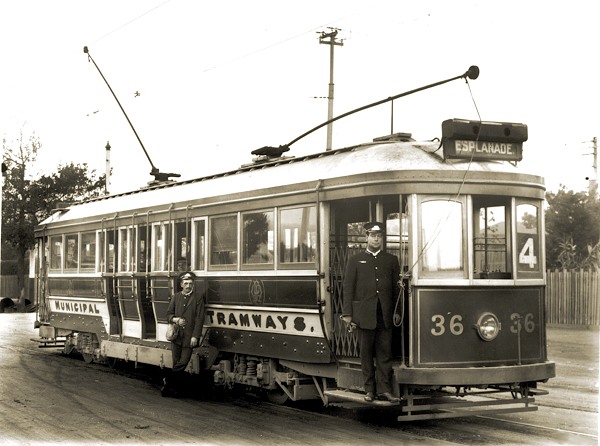
PMTT C class tram No 36 at Deepdene, circa 1914-15, showing the first style of route number display used by the Trust. Route number 4 terminated at the balloon loop at St Kilda beach, across the road from Luna Park. No 36 has destination boxes of the ‘Malvern’ type, which were used by several other tramway trusts in Melbourne.- Image courtesy of the City of Stonnington.
Table 2 – PMTT route numbers (1918)
Hawthorn & Essendon – not numbers but letters
From 1916, the Hawthorn Tramways Trust (HTT) used destination boxes of the ‘Malvern’ type as used by the PMTT, displaying two coloured night lights to identify the tram route as well as an illuminated destination blind. The coloured light combinations were selected to avoid duplication with PMTT route colours.
However, rather than using route numbers, the HTT identified its services by route letters, hanging a sign beneath the driver’s window as was the practice of the PMTT.
Table 3 – HTT route letters (1918)
The privately run North Melbourne Electric Tramways & Lighting Company (NMETL) operating out of Essendon Depot also introduced route letters, but without going to the expense of implementing coloured lighting codes. Instead, the large rectangular destination symbols mounted semi-permanently on the canopy roof were illuminated.
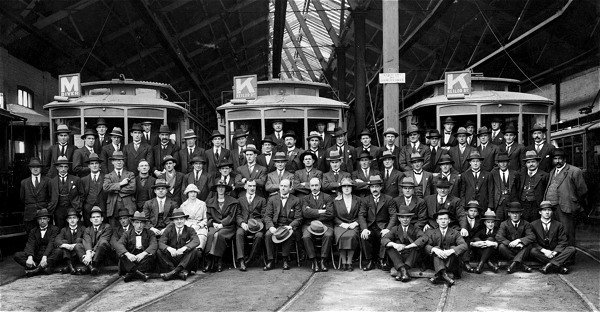
NMETL staff at Essendon Depot after the First World War. The large letter destinations for Keilor Road and Maribyrnong River provide clear labelling for intending passengers.- Image from the collection of the Melbourne Tram Museum.
Table 4 – NMETL route letters (1918)
Curiously, Essendon Depot was never in the suburb of Essendon. Instead, it is in the suburb of Ascot Vale, but has always been known as Essendon due to the name of the original municipality in which it was located.
The tram routes built by the Footscray Tramways Trust and the Fitzroy, Northcote & Preston Tramways Trust did not open until 1921 and 1920 respectively, after they were acquired by the M&MTB. When operations on their lines began, no route numbers or symbols were used. Destination names were displayed on trams in destination boxes of the type latterly used by the PMTT (known as ‘Malvern’ type destination boxes).
Early Tramways Board
The formation of the Melbourne & Metropolitan Tramways Board (M&MTB) in 1919 required new administrative arrangements. When the municipal tramways trusts were assimilated in February 1920, the M&MTB was divided into three divisions:
- Metropolitan – consisting of the cable tramways of MTOC and the single Clifton Hill to Northcote line of the Northcote City Council.
- Eastern – consisting of the tramways of the former PMTT and HTT.
- Northern – consisting of the tramways of the Fitzroy, Northcote & Preston Tramways Trust, the Melbourne, Brunswick & Coburg Tramways Trust, and the Footscray Tramways Trust. Two years later, the NMETL tramways were added to the Northern Division.
From an operational perspective, each of these divisions was largely left to its own devices. The Metropolitan Division repainted its colourful rolling stock in the new standard chocolate and cream livery, replacing the colour destination codes and painted destinations on car sides with destination blinds and boards, resulting in a significant saving in signwriting work. This move attracted major criticism from the public and the media, so the M&MTB relented slightly by painting the roof-mounted kerosene lamp chimneys in the old route colours. However, in 1924, Brighton Road trams (white) were through-routed to North Melbourne (green), which required the chimneys to be bi-coloured, showing white when travelling south and green when travelling north. This minor change would remain until the conversion of Swanston Street services to electric traction in 1926.
With regard to route indicators, the Northern Division made no changes to the existing signs, while the Eastern Division added the Hawthorn routes to the existing PMTT route number scheme, as per Table 5.
Table 5 – M&MTB Eastern Division route numbers (1921)
Standard destination boxes
The new W class trams entering service in 1923 introduced a new concept – the removable standard destination box. Mounted above the driver’s windscreens, the new boxes displayed the destination on a backlit linen roll. The linen rolls were painted with a black background, the letters of the destination left unpainted to maximise night-time legibility. Existing electric tramcars of all classes were progressively modified to accept the new standard destination boxes, only a few old single truck pre-M&MTB trams escaping modification before they were scrapped in the late 1920s.
Each depot had a standard destination roll, the lid of the box being marked with the assigned depot. For example, Hawthorn destination boxes were painted with the letters ‘HAW’. When a tram was transferred from one depot to another, the old boxes were whipped out, and the new ones popped in – a five-minute job. Production of tram destination rolls was a major activity at the new Preston Workshops.
The new W class trams also introduced side destination boxes mounted above the left-hand window in the drop centre section.
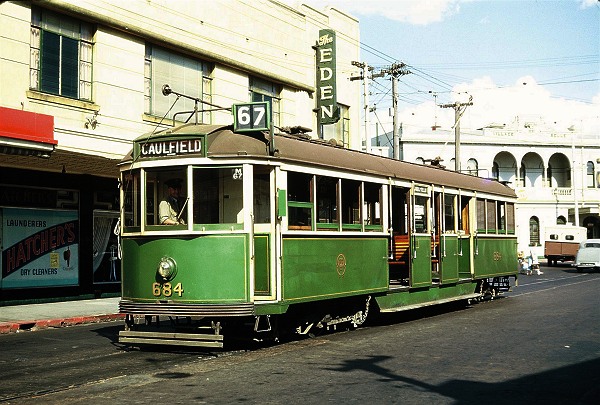
M&MTB CW5 class maximum traction bogie tram No 684 at the Acland Street terminus in St Kilda, about to return to Caulfield on a route 67 via Fitzroy and Wellington Streets in 1953. The side destination boxes are at the top of the leading window in the drop centre, while No 684 displays the classic M&MTB standard destination and route number boxes to good effect.- Photograph courtesy of Noel Reed.
The side destination boxes were built into the design of W2, W3, W4, CW5, and W5 classes in the same location as the initial W class trams, while the Y and Y1 class trams had side destination boxes above the centre doors. W1 class cars were not so fitted, due to their open drop centre sections.
The sliding door trams introduced from 1938 of SW2, SW5, SW6, W6, W7 and VR classes were not fitted with side destination boxes, due to the presence of the air-operated sliding doors. The standard X, X1, and X2 single-truck tram classes also did not have side destination boxes.
Side destination boxes on trams were progressively blanked over or removed from the 1950s onwards as an economy measure.
The introduction of the Z class cars in 1975 would see the return of side destination boxes, which have been a feature of every subsequent tram class. Note that the PCC prototype for the Z class was fitted with a side route number box, but not a side destination box.
System-wide route numbers
In 1925, the forthcoming conversion of Swanston Street cable tramway to electric traction caused the Eastern and Northern Divisions to be merged, as it would enable the majority of the electric tram system to be operated as a single entity, with the notable exception of the Footscray lines, which would remain isolated until 1954. The Eastern Division route numbers and coloured light codes fell out of use, as did the former NMETL route letters, and the rapid conversion of cable tram routes did not allow for the introduction of a consistent route numbering system. It was not until November 1928 that a new route numbering system began to be implemented, although it was applied only to electric tram routes.
Cable trams continued with their original routes and route names until the closure of the last two lines in 1940, never having any route numbers assigned, although the West Melbourne services were altered to terminate in Lonsdale Street in 1925, to relieve congestion at the Elizabeth Street terminus.
Table 6 – Trial M&MTB route numbers (1928)
Route numbers were reintroduced between Elsternwick and East Coburg on 19 December 1928, on a total of four routes. Route numbers were displayed on W2 class trams above the leading entrance of the car, but these displays were not a success.
Instead, all bogie tramcars of the ‘W’ and ‘L’ classes were fitted with roof-mounted illuminated route number boxes at each end of the cars, displaying two single-digit rolls, although single truck cars were never fitted with route number boxes. Route number boxes were also fitted to the pre-M&MTB maximum traction bogie trams of the ‘C’, ‘E’, ‘N’ and ‘P’ classes. The ‘Y’ and ‘Y1’ class bogie cars were briefly equipped with route number boxes in 1930, but they were soon removed, as their location above the front doors made it dangerous for traffic staff to operate the rolls.
By 21 November 1929 enough tramcars had been fitted with the new route number boxes to allow for the introduction of route numbers on Swanston Street routes, as outlined in Table 6a.
Table 6a – Initial M&MTB Swanston Street route numbers (1929)
Route number boxes contained two painted linen rolls, also backlit, each roll displaying a single digit or letter. The ‘tens’ blind showed the digits ‘0’ through ‘9’ (except for ‘3’), while the ‘units’ blind showed the digits ‘0’ through ‘9’ (except for ‘3’) and letters ‘A’, ‘B’, ‘D’ and ‘E’. Both blinds also included a blank character.
Single number route numbers were always displayed in the ‘tens’ blind, a practice which would continue on ‘W’ class cars at least into the 1980s. This simplified the use of letter codes, which in most cases were used for short workings on single digit routes, although this was not consistently applied. Therefore, at termini, when changing from a short working to a full length working or vice versa the tram crew needed to change the display for only one number at each end, saving a precious ten or twenty seconds – critically important for timekeeping when shunting at intermediate crossovers.
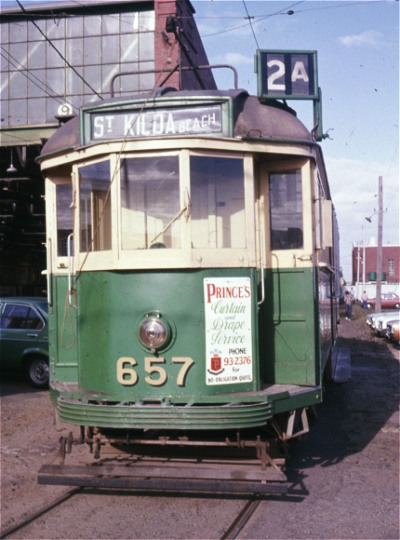
The 2012 introduction of letter suffixes by Yarra Trams for route numbers was not the first time this was done in Melbourne. From 1928 to 1970 letter suffixes were used to denote short workings of single digit route numbers. Here, stored W3 class tram no 657 displays route 2A for the City to St Kilda Beach via South Melbourne service, before 657 was disposed of and sold in 1981.- Image from the collection of the Melbourne Tram Museum.
The digit ‘3’ was not initially used in standard route numbers due to avoid confusion with ‘8’, particularly when wear of the canvas rolls resulted in a digit becoming partially obscured. Similarly, the letter ‘C’ was omitted from the roll to avoid confusion with ‘0’. This was important as route numbers were used by signalmen at key locations in the network such as St Kilda Junction and Franklin Street to identify which route should be selected for the next tram. The initial allocation of some route numbers was chosen to simplify the task of signalmen.
For example, at St Kilda Junction, the signalman switched all outbound or ‘down’ trams with route numbers from ‘4’ to ‘4E’ through to High Street and Brighton Road, while tram routes beginning with ‘1’ were switched to Fitzroy Street and all other routes went down Wellington Street.
Similarly, at Franklin Street northward bound Swanston Street trams on routes beginning with a ‘1’ or ‘2’ were switched through to Swanston Street north, while all other routes were switched to terminate in Victoria Street. However, later reallocation of route numbers would undermine this logic.
Where switching at busy junctions was not an important consideration, route numbers were grouped by tram depots, although some routes were shared between two or more depots. In particular, Hanna Street Depot (later known as South Melbourne Depot) had few dedicated routes, despite it being one of the largest depots on the Melbourne system.
Similarly to the use of letter codes for single digit destinations, short workings were often differentiated from the full-length workings by changing the number shown in the units’ blind. For example, of the routes allocated to Camberwell Depot, route 71 was a short working of route 70, and routes 75 and 76 were short workings of route 74. This practice would be a consistent feature of Melbourne’s tramways for decades to come.
The Victorian Railways’ tram routes from St Kilda to Brighton Beach and Sandringham to Black Rock and Beaumaris were not allocated route numbers, as they were never part of the M&MTB route numbering scheme.
The first changes to the allocation of route numbers occurred on 26 October 1930, with the diversion of East and West Preston services to Collins Street as the result of the conversion of the Brunswick Street cable tram services. Further changes were made in 1934 due to the reorganisation of services in the south-eastern suburbs, but by the end of the year all electric tram services had been allocated with route numbers, as per Table 6b.
Table 6b – M&MTB route numbers (1934)
Route numbers 4D and 7D were colloquially known as ‘fourpenny’ and ‘sevenpence’ respectively, as a ‘D’ was the accepted symbol for penny, which was also used on the flimsy tram tickets on issue.
The first major revision to the route number system after the introduction of route numbers across the entire system would come in 1935, following the conversion of the Elizabeth Street cable tram routes to electric traction, which resulted in moving most city-bound William Street services to terminate in Elizabeth Street.
The single truck tramcars allocated to the isolated Footscray system were never fitted with route number boxes, so the application of route numbers to those routes as per Table 6 was somewhat pointless. Accordingly, the wartime expansion of the tram system to support the new munitions factories in Maribyrnong saw the reallocation of these route numbers as from December 1940. The local Footscray routes would remain unnumbered until the closure of both these routes and Footscray Depot in 1962, despite construction of the connection with the main system in 1954.
The extension of the Essendon line to Essendon Aerodrome in 1943, to service the main aircraft servicing depot for the RAAF and USAAF in the South-West Pacific theatre, also received a new route number.
In 1937, the Holden Street shuttle from Lygon Street to St George’s Road was also un-numbered, as it too was operated almost exclusively by single truck cars not equipped with route number boxes. As the all-night services introduced in the same year were primarily operated by single-truck cars, they were also not allocated route numbers.
Table 7 – M&MTB wartime route numbers (1943)
City termini
One of the characteristics of Melbourne’s electric tramways during the twentieth century was the use of CITY as the destination of all services bound for the central business district, no matter which terminus was used. While this simplified the production of destination rolls for the various depots, it required passengers to have local knowledge, which was unfortunate for visitors from out of town.
This was such a quirk of the system that the standard text on M&MTB tramcars was titled Destination City. One of the interesting outcomes of this feature was that there were tramcars travelling both directions on Swanston Street and on Collins Street showing the same destination: CITY. Only the route number would inform the intending passenger where the tram was heading.
The main city termini during the M&MTB era were as follows:
- Victoria Street: northbound Swanston Street services.
- Nolan Street (formerly City Road): southbound Swanston Street services.
- Princes Bridge: Batman Avenue services.
- Flinders Street: Elizabeth Street services.
- Dudley Street: northbound William Street services.
- Queensbridge (formerly William & Collins Street): southbound William Street services
- Brunswick Street & Victoria Parade: eastbound Collins Street and Latrobe Street services.
- Spencer Street & Collins Street: westbound Collins Street services.
- Spencer Street & Bourke Street: Bourke Street services.
- Spencer Street & Lonsdale Street: Flinders Street services.
- Spencer Street & Latrobe Street: Latrobe Street services.
There were several intermediate crossovers used as termini for short workings or alternatives due to congestion, or due to street closures for special events. Only a few were allocated route numbers, but most were represented with their own entries on destination blinds.
- City – Russell Street: destination used for short workings to crossovers in both Collins and Bourke Streets.
- City – Queen Street: used for short workings in Bourke Street.
- City – Elizabeth Street: used for short workings in Collins Street.
- City – Gisborne Street: used for short working Collins Street services.
- City – Swanston Street: used for short working Flinders Street services.
- City – Market Street: used for short working Flinders Street services.
- City – Corner Flinders & Spencer Streets: used for short working Flinders Street services.
- City – Queensberry Street: used as an alternative terminus to Victoria Street for some northbound Swanston Street services.
- City – Lonsdale Street: destination used for short workings to crossovers in both Swanston and Elizabeth Streets.
With the retirement of most W class trams except those on the City Circle, and the introduction of programmable destination displays on more modern vehicles, CITY is no longer used as a destination. Most services no longer terminate within the central business district, and those that do have been given a more descriptive title such as ‘St Vincent’s Plaza’ for Gisborne Street or ‘City – Flinders Street Station’ for Elizabeth Street services.
Special places to go
There were more than a few destinations on rolls used by the M&MTB electric trams that weren’t associated with route numbers. Some of them appeared on all depot rolls, while others were specific to just one or two depot rolls.
The most important of all was FOOTBALL. Melbourne has its own sporting religion – Australian Rules Football – which was historically worshipped on Saturday afternoons from March through to September, although now with the transformation of the Victorian Football League (VFL) into the Australian Football League (AFL), the devotional days have spread to include Fridays, Sundays, Mondays, and the occasional Thursday.
All the home grounds of the original Melbourne-based VFL teams were located close to M&MTB tram lines. Additional services were required on Saturdays to handle crowds of 30 to 40 thousand spectators at each of the home and away games, or up to 100,000 at a finals game, and they all went to FOOTBALL. Crossovers were placed near the grounds to facilitate shunting of the football workings, while some locations had their own sidings where trams could wait until the end of the game without disrupting normal services, such as:
- Simpson Street, East Melbourne, for the Melbourne Cricket Ground and Richmond Football Ground.
- Albert Road, South Melbourne, and Albert Park Beach, for Lake Oval.
- Napier Street, Essendon, for Windy Hill Oval.
Football wasn’t Melbourne’s only sporting obsession serviced by the M&MTB and recognised on destination rolls. Special services to horse racing meets at Flemington, Moonee Valley and Caulfield showed the destination RACECOURSE. Caulfield even had its own double tracked loop to handle the crowds attending regular race meets including the Caulfield Cup, although this has now been replaced by a single siding in Dandenong Road.
Most destinations without associated route numbers referred to specific locations. Continuing the sporting theme, the Melbourne Olympics of 1956 brought the destination of OLYMPIC PARK, serving the various stadiums on Swan Street. ZOOLOGICAL GARDENS, or latterly ZOO, was used for the crossover at the rear entrance of the Melbourne Zoo in Royal Park, on the West Coburg line. When the University of Melbourne was the sole university in town, select peak hour Swanston Street services extended to the crossover servicing that august institution only needed to be identified as going to UNIVERSITY for everyone to know where they were going. There were many others, such as the wartime destination of PYROTECHNICS FACTORY on the Footscray local lines, or the botanical sounding LEURA GROVE on the Camberwell line in Burke Road.
One special destination that did have a route number was SHOWGROUNDS (route 58), which was vitally important for ten days every September, to take thousands of city dwellers to the Royal Melbourne Show in Ascot Vale to view the fruits of the agricultural sector. It was also used to take punters to and from harness racing meetings at the SHOWGROUNDS during the rest of the year, and had a long siding to store trams waiting for the crowd to exit after the final race.
Like the Melbourne Cup, the Show also revelled in a public holiday, the last Thursday in September. Unfortunately, this holiday was abolished by the Kennett government in 1994, much to the regret of schoolchildren and the Royal Agricultural Society of Victoria.
The most special of all destinations used by the M&MTB was SPECIAL, which indicated services that did not pick up ordinary passengers. It was used for many different purposes including charters, scrubber or other works trams, driver training trams and car transfers to other depots or the workshops.
While Yarra Trams still run services to sporting events such as the football, races and cricket, or the tennis and grand prix, like the destinations for city termini more descriptive displays are used, indicating the name of the venue or sporting event. Disappointingly, Melbourne trams are no longer special. Instead, when not picking up passengers, the destination displays now show ‘Not Taking Customers’ [1].
Footscray connection and Bourke Street conversion
In October 1940, the last cable tram routes in Melbourne – the Bourke Street lines – were finally abandoned. Rather than being converted to electric traction, they were replaced by diesel buses, both single and double deck. However, the passenger loadings on these routes were too heavy to be handled effectively by the buses. In 1943, the decision was made that the Bourke Street buses would be replaced by electric trams after the end of the Second World War.
The economic conditions and lack of materials meant the conversion to electric traction did not occur until 1955-56, in time for the Melbourne Olympic Games.
Before the Bourke Street conversion was undertaken, the isolated Footscray lines were connected to the rest of the network in 1954, creating a new route from Footscray to Moonee Ponds, together with several short workings from Footscray railway station and Moonee Ponds to the various defence industry factories adjacent to the lines.
The new routes were allocated numbers in the eighties and nineties, extending the existing route numbering system. It should be noted that peak hour services diverted to Latrobe Street or William Street from their normal routings were not allocated separate route numbers. This was also the case for Swanston Street trams that were extended to terminate at Queensberry Street or University rather than Victoria Street.
The route numbers assigned to the Point Ormond line were retired when it closed in 1960.
Table 8 – M&MTB route numbers (1962)
Threes appear and no more letters
The first use of the digit ‘3’ in M&MTB route numbers occurred in August 1968, when 13 was allocated to West Preston trams routed to the City on Latrobe Street. This action required the replacement of the rolls in route number boxes to include ‘3’. Five months later, on 20 January 1969, route 53 was allocated to the St Kilda Beach-City service via William Street.
On 1 November 1970, a major restructure of route numbers was implemented. All letter codes were abolished, and the digit ‘3’ was widely introduced as a valid component of route numbers. Most of the number range in the previously unallocated thirties was allocated to peak-hour services from the south-eastern suburbs operating to William Street rather than Swanston Street.
This change was implemented as part of a new Melbourne-wide route numbering system covering trams and buses for all operators. Trams were allocated routes 1-199, M&MTB buses were allocated routes 200-399, while all routes operated by private bus lines were allocated numbers above 400. The Victorian Railways’ tram routes in the bayside suburbs were not allocated numbers, as they had been closed over a decade before this initiative.
By 1969, manned signal boxes at junctions had been largely replaced by automated driver-activated points, except for the Franklin Street Box at the top end of Swanston Street. This last signal box would remain in use until 1991, as the volume of traffic still justified the labour cost of a dedicated signalman at this one location.
However, the disappearance of signal boxes removed much of the rationale for the original route numbering scheme of 1930. No longer was there a requirement for a signalman to rapidly identify the destination of a tram from the ‘tens’ digit, as now drivers were in control of the points.
A practice that began at this time was the use of double-zero (00) as the route number for any run returning to a depot, although this was not consistently implemented across the system.
One remnant of the old route number system remained, however. The practice of using the ‘tens’ column for single digit routes on W class tramcar route number boxes would persist well into the 1980s – no doubt more as a result of tradition than any other reason.
Table 9 – Melbourne tram route numbers (1974)
Outer suburbs and light rail
The introduction of the Z class trams in 1975 saw the introduction of flip-over destination boxes and route number boxes, making the old destination rolls used by the W class obsolete. Clearly, M&MTB management had expansionary ideas, as the Z class route number boxes were set up for three digits, not the two digits of the W class – indicating the potential for a larger tramway network.
The first extension made after the Z class appeared – to East Burwood in 1978 – saw the reallocation of a short working number on the same route to the new terminus, becoming route 75 rather than route 74, the latter number being retained as the short working to Burwood. Subsequent extensions of the East Preston line to eventually terminate at Bundoora saw the allocation of routes 86 and 87, previously used in the western suburbs.
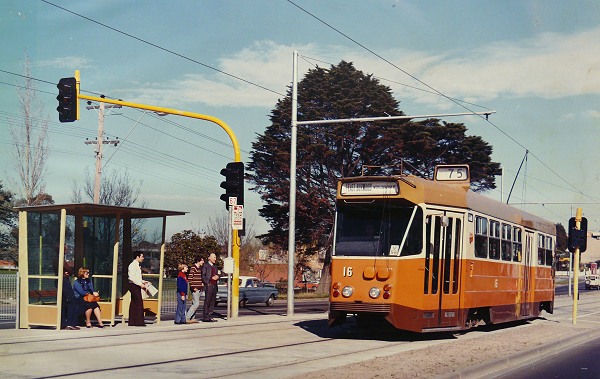
M&MTB Z class No 16 in Burwood Highway accelerating away from the stop for Presbyterian Ladies College towards the East Burwood terminus in 1978. The flip-over destination signs were original equipment for these trams, the route number box allowing for expansion of the tramway system by supporting three digit route numbers.- From the collection of the Melbourne Tram Museum.
Other changes during this period included the cancellation of south-eastern suburban peak hour services to William Street in November 1986 as a cost saving measure, and the removal of the Batman Avenue city terminus in May 1999 to make way for Federation Square – the remaining Wattle Park services were redirected to Flinders Street, while the City to Prahran service (route 77) which had formerly used Batman Avenue as the city terminus had been withdrawn in 1986. Also, the city terminus for most Swanston Street routes was changed from Victoria Street to Melbourne University. Other city-based network developments were the extension of lines into the new suburb of Docklands, and the creation of the free City Circle service (route 35).
The conversion of the Port Melbourne heavy rail line to light rail in 1987 saw the allocation of the first three-digit route number in Melbourne, route 111. Six years later, route 42 to Mont Albert was combined with 111 and renumbered to 109. When the St Kilda rail line was converted to light rail operation, route 96 was extended to terminate in Acland Street without any renumbering.
South Melbourne Depot was closed and replaced by Southbank Depot in 1997. Likewise, North Fitzroy Depot closed in 1993, although it briefly reopened during 2008-09 to house City Circle trams during construction work at Southbank Depot.
The privatisation of Melbourne’s trams in 1999 saw no fundamental change in the route number structure, although routes running on north-south streets in the city were allocated to Swanston Trams (later M>Tram), while those on east-west city streets were operated by Yarra Trams. This situation continued until April 2004, when all tram routes became the responsibility of Yarra Trams.
Table 10 – Yarra Trams and M>Tram route numbers (2000)
Programmable screens
The introduction of programmable destination screens on its tram fleet has provided Yarra Trams – with the exception of the few remaining W class trams on the City Circle – with significantly more flexibility in the display of route numbers and destinations. Trams with these screens are programmed with every destination on the Melbourne system.
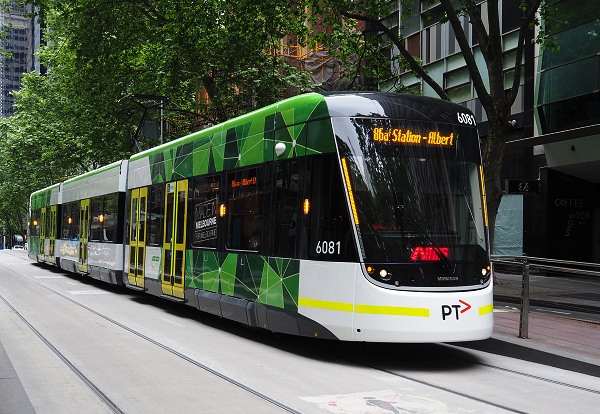
Yarra Trams E2 class tram No 6081 in Bourke Street, on a short working route 86a on 10 November 2019. The programmable display is scrolling the long destination text, while the route number is displayed on the left, following European practice.- Photograph courtesy of Geoff Brown.
After privatisation of the system, infrastructure savings were obtained by removal of many intermediate track crossovers. Additionally, population growth on the outer sections of most tramlines resulted in increased patronage and changes in traffic patterns. These two factors have caused the reduction or outright elimination of many short workings, particularly on the outer sections of longer routes. Consequently, many route numbers assigned to short workings have fallen out of use, or have been reassigned to other routes.
The end result has been that the underlying logic behind the original allocation of route numbers has evaporated, leaving the public – mostly unaware of the history behind route number allocation – with the impression that numbers have been assigned more or less at random, with large gaps between numbers for no apparent reason, except for the accident of history.
The infrequent use of the remaining short workings left Yarra Trams with a difficult problem – when they were used to improve service density on the inner portions of the network, the public were reluctant to use trams with unfamiliar route numbers, defeating a major reason for introducing short workings. The media labelled these apparently mysterious tram route numbers ‘ghost trams’, primarily due to them not appearing on public timetables. Yarra Trams claimed this practice was due to a desire not to confuse the public with rarely used route numbers.
To meet this challenge, in 2012 Yarra Trams re-introduced route letters to Melbourne trams, suffixing route numbers with either ‘a’ or ‘d’, eliminating individual route numbers for any remaining short workings altogether.
- The ‘a’ suffix is used to denote a short working, often as a result of service disruptions such as track or overhead maintenance. There is no permanent assignment of the suffix to any particular short working on a route, as passengers are expected to familiarise themselves through reading traffic notices, viewing the Yarra Trams website or social media feeds. The only exception to this rule is on the weekends-only route 3a, which is an alternate routing of route 3 to East Malvern via St Kilda, instead of the normal weekday routing via Brighton Road.
- The ‘d’ suffix denotes a short working direct to a tram depot, rather than to the normal terminus.
While this rule is logical enough, it does not address the three-character limitation [2] on the older programmable destinations – such as what number does a depot working from Port Melbourne use – nor does it address depot workings of the City Circle route 35 operated by W class trams still fitted with the traditional two-digit route number boxes. It also leads to the vexing question – is there a weekend route number 3aa? Apparently not.
There is further confusion with use of route 48d from the terminus of Victoria Harbour. One would think that a 48d tram returns to Kew Depot via Wellington Parade and Bridge Road, following route 48, but this is not the case. Instead, once it departs the CBD, 48d trams follow the path of route 109 via Victoria Street to get to Kew Depot rather than the path of route 48 – which is disconcerting for passengers wishing to only travel part of the way back to the depot.
Over the years, tram passengers have become accustomed to the idiosyncratic nature of their route numbers. It seems some illogicality is required, otherwise it would not be Melbourne.
However, the new route structure largely preserves the old route numbers, in the effort to minimise public confusion by not introducing an all-out new numbering scheme. This desire to implement gradual minimal change is also illustrated by the combination in May 2017 of the West Coburg (55) and Toorak (8) services into a through routed number 58 service, while Glen Iris (6) was extended from Melbourne University to Moreland. Similarly route 112 West Preston to St Kilda Beach route was divided into routes 11 West Coburg to Victoria Harbour and 12 Victoria Gardens to St Kilda Fitzroy Street.
Table 11 – Yarra Trams Route Numbers (2019)
One cross-country route number caused much amusement to teenage school students, as the southern terminus was notorious as Melbourne’s red-light district. This was, of course, route 69 from Kew Cotham Road to St Kilda Beach. To the regret of the many students who frequented it to and from elite private schools along Glenferrie Road, route 69 disappeared when it was combined with the St Kilda Beach to Melbourne University route 16.
Route structures were further simplified in July 2014 by the elimination of the part-time Chapel street service between North Richmond and St Kilda Beach (route 79). Instead, all Chapel Street services would be operated as route 78 trams.
The abolition of short working route numbers has been facilitated by the implementation of comprehensive automated vehicle monitoring (AVM) in the Yarra Trams Operation Centre. This has enabled the uncoupling of route numbers from the function of vehicle control, as individual short workings are now identified by means other than dedicated route numbers.
The introduction of imported trams – initially the Citadis and Siemens trams – saw the ending of a Melbourne tradition. The route number was no longer displayed to the right of the destination, which was the side closest to intending passengers. Instead, the new imported trams followed European practice by displaying the route number to the left of the destination – a retrograde step, as Melbourne trams ran on the left track, while the Europeans operated on the right-hand track. Even the new E class trams – built in Melbourne – display route numbers on the left, placing the route numbers further away from passengers at stops other than those few with centre platforms.
So, what is the oldest unchanged tram route number in Melbourne?
The answer is: route 78, North Richmond – Balaclava.
This tram route number has remained unchanged both in the actual route travelled and the route number allocated since it was allocated in 1934. However, Yarra Trams has renamed the southern terminus from Prahran to Balaclava, aligning it with the actual suburb name of the terminus – which makes a great deal of sense. The old PRAHRAN designation of the terminus descended from its cable tram predecessor that ran along Chapel Street, which was always flagged as the Prahran line, although it terminated in Windsor.
The route number with the longest association with a destination, on the other hand, is route 1 – which has remained linked with the northern terminus of East Coburg since the first M&MTB trials of route numbers in 1928.
Enthusiasts wishing to know more about the use of individual route numbers should check out the links in the bibliography, especially those written by Storey, Woolcock and Waldron.
Bibliography
Bowen, D. (2012) Hidden Meaning in Route Numbers, danielbowen.com, 11 January 2012
Brady, I.A. (2011), Prahran and Malvern Tramways Trust – Melbourne’s Foremost Municipal Tramway, Transit Australia Publishing
Jones, R. (2003), Fares Please – An economic history of the Melbourne & Metropolitan Tramways Board, Melbourne Tram Museum
Jones, R. (2004), Northcote: the on again, off again cable tramway, Melbourne Tram Museum
Jones, R. (2008), Steady as she goes: the Prahran & Malvern Tramways Trust, Melbourne Tram Museum
Jones, R. (2013), Haunting the Rails: Ghost Trams of Melbourne, Melbourne Tram Museum
Keating, J. D. (1970), Mind the Curve!, Melbourne University Press
Keenan, D.R. (1974), Melbourne’s Tramways In 1974, Transit Press
Keenan, D.R. (1985), Melbourne Tramways, Transit Press
M&MTB (1934), Centenary Souvenir 1934-5, The Mail Publishers
Sexton, R. (2008), On Our Tramway’s Secret Service, The Age, 14 September 2008
South Pacific Electric Railway (1999), Here and There – Batman Avenue Closure, Trolley Wire, August 1999
Storey, D. (2016), Melbourne Electric Tramways Gunzel Notes
Victorian Heritage Database (2000), Tramway Signal Cabin, Heritage Council Victoria
Waldron, H. (2009), History of Melbourne Tram Routes from 1950 to 2009, Yarra Trams
Wong, M. (2020), Confusion abounds on route 48d to Kew, Waking up in Geelong, 14 January 2020
Woolcock, A. (2012), Every number (and letter) ever used, Yarra Trams
Yarra Trams (2019), Timetables & routes
Footnotes
[1] Public Transport Victoria policy as at 2020 is for special service trams to display ‘Not Taking Passengers’, although this is yet to be fully implemented across the tram fleet.
[2] From late 2019, most tram route number programmable displays could display four character route numbers.